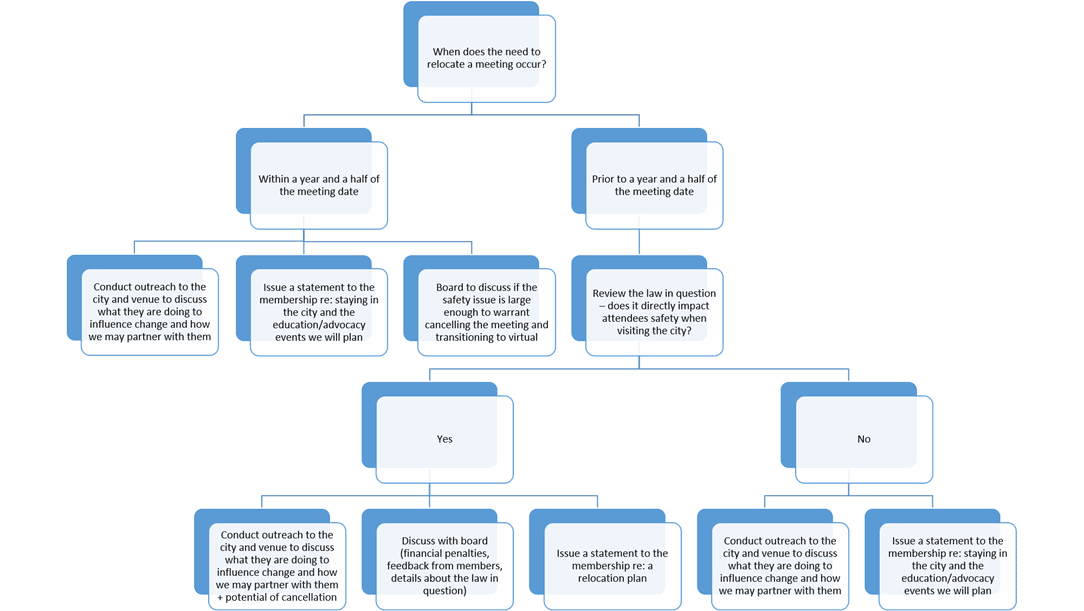Site Selection Policy
In selecting locations for meetings and events, particularly the Annual Convention, the Society for Personality and Social Psychology strives to ensure that meeting locations meet the needs of our convention and our attendees.
In making siting decisions, SPSP shall consider the following factors:
- Overall meeting package: Meeting space requirements, number of sleeping rooms, concessions
- Accessible facilities: Ensuring accessibility at our meeting, including ADA compliance and inclusion for all attendees. This also involves considering the layout of the meeting space and the amount of walking required.
- Contiguous properties: Enough sleeping rooms within walking distance of meeting rooms.
- Low costs: Keep attendee costs as low as possible.
- Hotels must commit to a discounted room rate for our student attendees.
- Complimentary Wi-Fi in sleeping rooms and meeting space is required. Wi-Fi in meeting space needs to be adequate to ensure access to any virtual programming that may be offered (e.g. downloading handouts, watching videos, participating in live streams).
- SPSP will continue to evaluate virtual offerings associated with the Convention to help meet the goals of access, inclusion, and climate impact.
- Locations: Cities that are geographically accessible both to travel to and to travel around.
- Rotation: Rotate meetings within the United States to increase regional access. SPSP will strive to collaborate with local organizations, universities, and community colleges to promote interest and membership in new and underrepresented communities.
- Airlift: Locations must have access to airports with sufficient capacity and accessibility to accommodate a large number of attendees from around the country and the world. In addition, reviewing the number of canceled flights in destinations over our meeting dates.
- Local resources: Walkable destinations, public transportation options, as well as hospitality and cultural resources.
- SPSP will continue hosting the Annual Convention in the contiguous United States due to the large proportion of members traveling from within the United States; hosting the convention outside the United States will dramatically increase overall attendee expenses and carbon footprint. SPSP will explore partnering with international organizations for hosting meetings in international destinations.
- Safety: Destinations where attendees have a reasonable basis for feeling safe when attending the meeting. We will use information provided by GeoSure and the Human Rights Campaign when evaluating cities.
- Non-discrimination and minority rights: Discriminatory settings and policies that abridge any attendee's rights make a safe atmosphere impossible to achieve. SPSP will prioritize destinations that do not have policies and practices in place that discriminate against meeting attendees for their age, gender identity, racial/ethnic identity, national origin, sexual orientation, disability, or religion.
- SPSP will take into consideration whether locations are on California's prohibition list, but may select locations from that list if they are the best across other criteria.
- SPSP will aim to sign agreements that include a provision in force majeure for the passing of laws (by local or state municipalities or governments) that discriminate or remove protections from discrimination.
- The city, venues, and vendors must have a commitment to diversity and equitable and inclusive practices. These details will be required as part of the RFP process. We will score each city based on this scale:
- 3: Exceptional - Clearly and strongly advances SPSP's goal of equity, inclusion, and anti-racism
- 2: Satisfactory - Slightly to moderately advances SPSP's goal of promoting equity, inclusion, and anti-racism.
- 1: Not Satisfactory - Does not advance SPSP's goal of promoting equity, inclusion, and anti-racism
- Timing: U.S. federal government holidays and other major religious/cultural holidays (e.g. Lunar New Year, Eid al-Adha) will be avoided when possible. The pattern of the convention will remain as Thursday – Saturday and in the second half of February/early March time period.
- Sustainability: SPSP understands the environmental consequences of holding large meetings, so destinations with green initiatives will be considered favorably.
- Partnership with the convention and hospitality industry: SPSP strives to work with local Convention Visitors Bureaus (CVBs), hotel chains, and other vendors in ways that build long-term positive relationships. SPSP also strives to work with minority- and/or women-owned businesses and contractors where circumstances allow.
- Weather: The SPSP convention has typically been held in warmer climate destinations because it is held in February/March. Doing so creates a lower likelihood that attendees' travel will be restricted by winter storms. The weather will remain a consideration moving forward, but it will not be a limitation.
Request for Proposal and Decision-making Process
- Staff will distribute a survey request to the membership regarding a list of meeting destinations for consideration (Fall). We will ask members to identify any concerns they have regarding the destinations and share alternative destinations we may want to consider.
- Staff will work with a third-party vendor to distribute a request for proposal to the approved cities (Fall). We will try to do three years at one time to take advantage of potential opportunities for multi-year agreements with specific hotel brands and this may be necessary to accommodate the various priorities listed above.
- Staff will conduct site visits of the most feasible proposals in March/April.
- Based on the proposals received, staff will present two recommendations per year to the Convention Committee (Spring).
- The Convention committee will select their preferred proposal and submit a formal motion to the Board of Directors for approval (Spring).
- The Board of Directors will approve the selection at their summer meeting.
Relocating a Meeting Decision-making Process


